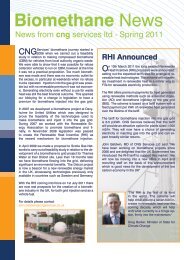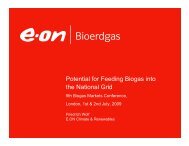Bio-SNG - CNG Services
Bio-SNG - CNG Services
Bio-SNG - CNG Services
Create successful ePaper yourself
Turn your PDF publications into a flip-book with our unique Google optimized e-Paper software.
BIO-<strong>SNG</strong> FEASIBILITY STUDY – ESTABLISHMENT OF A REGIONAL PROJECT10 ConclusionsMethane is an attractive heat and transport fuel vector. <strong>Bio</strong>-<strong>SNG</strong> is a production route which offers thepossibility of substantial scale renewable methane for injection into the grid and use in transport.Transition from aspiration, to widespread operating facilities and infrastructure requires a detailedunderstanding of the technical and commercial attributes of the full chain from feedstock supply throughto delivery of grid quality gas, as well as the development of the first crucial operating facility whichprovides the tangible proof of concept for roll out.Implementation of <strong>Bio</strong>-<strong>SNG</strong> will only take place with the appropriate tax, incentive and legislativeenvironment. Incentives must be structured such that such projects are commercially attractive comparedwith competitive users of biogenic energy resources, and the regulatory environment must be clear andappropriate.Whilst there is substantial indigenous and international biomass resource in the form of „pure‟ biomassand waste derived fuels, it must be appreciated that there are competing uses for biomass in manyindustrial sectors – building materials, chemicals, heating, electricity generation, and transport bio-fuels.Securing feedstock on contracts of sufficient term and appropriate price for financing presents achallenge, and it is likely that the development of <strong>Bio</strong>-<strong>SNG</strong> facilities will require the developer to goupstream into the supply chain for both grown and waste derived fuels. From a technical perspectivebiomass fuels are generally less well understood than fossil fuels, and the technologies that use biomassfuels are less well developed, however, specification and quality control are vital determinants of projectsuccess.In principle, the major process operations required to produce <strong>Bio</strong>-<strong>SNG</strong> can be identified and assembledfrom existing technology suppliers. This does not mean that a <strong>Bio</strong>-<strong>SNG</strong> development would be free fromtechnical risk, but it does mean that there is no fundamental process development required to create aviable <strong>Bio</strong>-<strong>SNG</strong> platform. The essential first condition that must be satisfied is that feedstock specificationand the process design are matched. It is proposed in this work that established gasifier configurationsare adopted, such as direct fluidised beds, rather than emergent technologies. Downstream of thegasifier the gas processing operations are conventional technology: heat recovery and power generation,gas scrubbing, water gas shift, methanation, conditioning and compression. Whilst these processingelements are all conventional, they are critical for ensuring pipeline quality gas. In general the GS(M)Rspecification should be attainable by this process route, although the tight limit on hydrogen content maylead to unnecessary processing.Two representative scales of facility at 50MWth and 300MWth input would produce approximately230GWh and 1400GWh of <strong>Bio</strong>-<strong>SNG</strong> per annum. This represents sufficient gas for approximately 15-84









